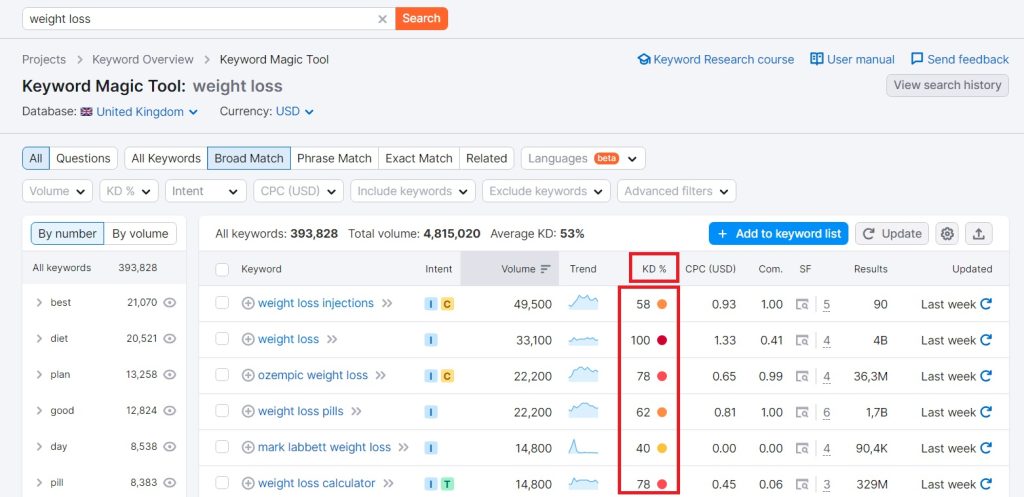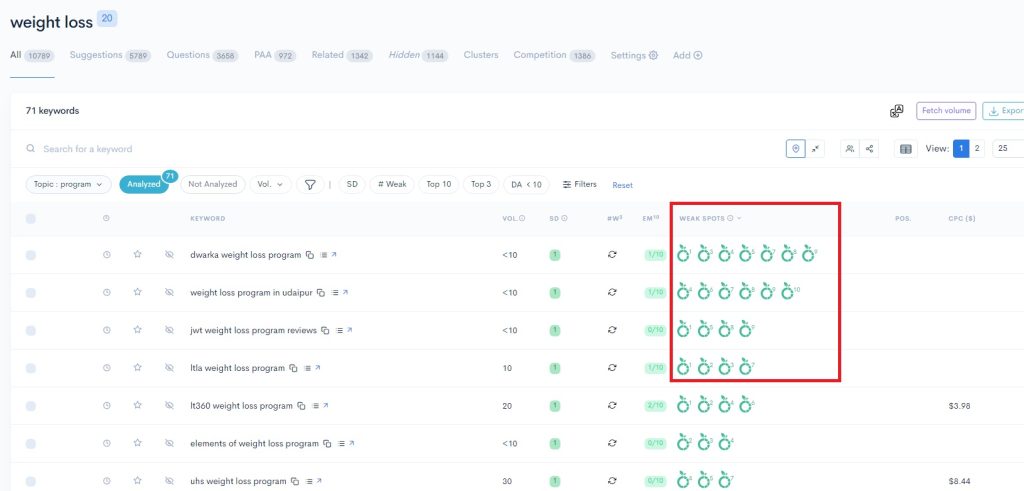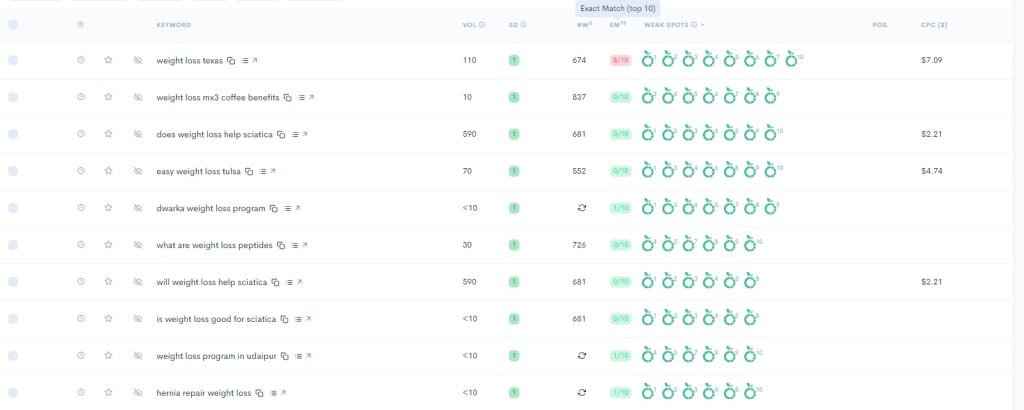How To Measure The Difficulty & Easiness of a Keyword in SEO (3 Main Ways)
Georgi Todorov

There are 3 main ways to analyze how easy it will be for you to go after a keyword:
- Keyword difficulty
- Low DA websites ranking on 1st page (weak spots)
- AllInTitle (Keyword Golden Ratio)
In this article, we will go over these 3 ways, what they are, and how you can find easy keywords with them.
| Research Method | What is it? | How to find easy keywords | Is it reliable? |
| Keyword Difficulty | Calculates the keywords’ difficulty from 1-100 based on competition. | Filter for KD to find easy keywords. | Reliable, but not entirely since there could be a few but strong competitors. |
| Weak Spots | The amount of low DA sites ranking on 1st page for the keyword. | Look for keywords with a few weak domains ranking on 1st page. | Reliable since it’s keyword data you can analyze yourself given accurate SERP data. |
| AllInTitle/KGR | KGR : Divides the number of competitors that have used the keyword in their titles by the search volume. | For each keyword, divide their AllInTitle results by their search volume. | Reliable, but shares the same issue with KD that it doesn’t consider when there is little but strong competition |
How to analyze keyword data with keyword difficulty
”Keyword difficulty” (KD) is a score from 1 to 100 given by popular SEO tools on keywords.
The data is based on the strength and number of websites going after the keyword.

Each SEO tool has its unique formula for calculating keyword difficulty, but the estimates are close.
The concept of KD is quite simple for SEOs to understand – you just have to go after the keywords whose difficulty is in the ”green”.
These would be the keywords with KD from 0 to 30.

How to find easy keywords with Keyword Difficulty
The keyword difficulty score is something that has already been calculated by the tools.
This is why SEOs should not do much analysis, other than to set a filter.
After you input your seed keyword, you just need to filter by keyword difficulty.

From this point on, it becomes a matter of selecting keywords that would be right for your brand and topic.
Is the keyword difficulty metric reliable?
Keyword difficulty is mostly a reliable metric, but not always.
Just because the tools say that a keyword has <10 KD does not mean that you will necessarily rank for it on 1st page.
This is because the tools calculate the whole landscape – everyone who has written on the topic.
But what will happen if 20-30 websites write on the topic and they are all authoritative?
SEO tools will tell you that the keyword has little keyword difficulty, but you will rank on the 2nd or 3rd page for it.
This leads us to the next way of analyzing keywords via ”weak spots” that tackle this exact problem.
How to analyze keyword data with Weak Spots
SEO tools, like LowFruits, evaluate keyword data based on the strength of the websites that already rank on 1st page.
By using an SEO tool you can analyze the SERPs to find which keywords have low-DA websites ranking on 1st page.

The green fruits are websites that have DA<20 and the number signifies the position they hold on 1st page of Google.
That means you will be able to overtake these weak domains and take their spots as long as you create better content.
Such keyword analysis is available in a limited range of tools, such as LowFruits and Keyword Chef.
How to find easy keywords with weak spots
SEO tools that offer SERP analysis of the keywords charge you in credits (1 credit per keyword analyzed) for the keywords you are analyzing.
This is why it’ll be quite pricey to analyze tens of thousands of keywords at once.
To find easy keywords, first select the keyword topic you are interested in for your blog.

After that, select all the keywords and click ”analyze” to extract their SERP data.

And for the subscribers of LowFruits, we offer a metric for ”SERP Difficulty Score” that scores keywords from 1-3.
It’s calculated based on the historical difficulty of the keywords, as long as another LowFruits user has analyzed them before.

Are weak spots a reliable way to calculate difficulty?
With weak spots data, you are presented with facts rather than a calculation of some sort.
That means weak spots are reliable in the sense that you are making the decision whether you believe a keyword is easy.
That makes it slightly harder to analyze than being presented with a number from Keyword Difficulty.
But more reliable once you get the hang of it.
To make weak spots more reliable, you should take into consideration a few things:
- Are the weak spots in the top 5 results or the bottom 5 results on the 1st page?
- Is there just 1 weak spot or multiple ones?
For example, 1 weak domain ranking on position 9 would probably not be worthwhile.
But 3 weak domains ranking in the first 5 positions would be a quick win.
How to analyze keyword data with AllInTitle (Keyword Golden Ratio)
AllInTitle analysis is when you calculate the keyword difficulty based on the search volume and number of competitors.
It’s a strategy where the goal is to prioritize keywords that have both sufficient search volume and are not that competitive.

By typing ”allintitle: keyword” you will see exactly how many title tags the target keyword appears.
The goal is to combine this data with search volume to calculate which keywords have good demand and not that much competition.
How to analyze keywords with AllInTitle
Also known as the ”Keyword Golden Ratio”, the formula goes as follows:
Keyword Golden Ratio = AllInTitle/Search Volume
Using the SERPs from earlier on ”weight loss for men” with 54,400 results, we calculate the following:
KGR = 54,400/720 (AMSV) = 75.5
That’s not a very easy keyword by any means.
And the process is quite manual – we want to be able to do it for many keywords.
And then you want to prioritize starting with the lower number keywords.
LowFruits offers a similar feature where you are presented with AllInTitle data for the 1st page of Google, not the whole landscape.

That allows you to see by how many competitors has the main keyword been targeted.
An Exact Match of ”0/10” would mean that no one on 1st page specifically uses the target keyword in their titles.
Is the Keyword Golden Ratio a reliable metric?
The KGR is primarily a way to prioritize keyword lists, and for that proves to be quite reliable.
However, the problem with KGR is similar to the problem of keyword difficulty.
For keywords that have little but strong competition, you will still fail to rank on the 1st page for your term.
Which keyword analysis method should you use out of the 3?
All 3 methods provide a useful way of analyzing keyword data.
If you are a low DA website or a niche site owner, you should use Weak Spots
This is because you will be able to spot for which keywords you can rank as other low DA websites are ranking.
It will become a matter of creating better content than them.
If you are a medium-to-high DA website, keyword difficulty will make sense for you
This is because you’d be more interested in the overall competitive landscape and not just the 1st page of Google.
And in the meantime, I’d use the Keyword Golden Ratio to prioritize keyword lists
Personally, I use the KGR to prioritize keyword lists, rather than find easy keywords.
I find keywords with 2+ weak spots using LowFruits and then use AllInTitle analysis to figure out how to prioritize the content calendar.
Should you use a combination method of the 3?
Sure, but it will get expensive. After all, you’d have to use 3 different (paid) SEO tools to do that at scale.
Here’s how I’d combine the 3 methods if I had access to these 3 tools:
- Start with Semrush to filter for a keyword difficulty of 0-30 to get my initial keyword list of low-competition keywords
- Export the list to LowFruits and analyze the keyword list to find which keywords have weak spots
- Prioritize the LowFruits keyword list of easy keywords with AllInTitle analysis